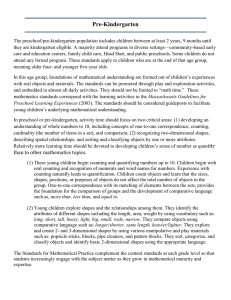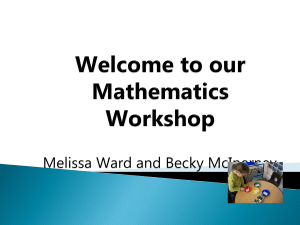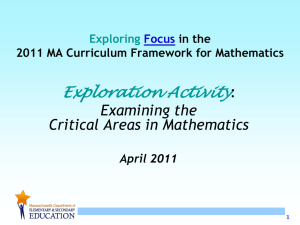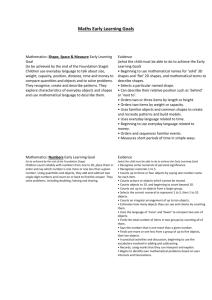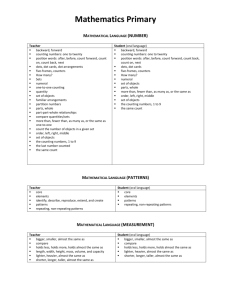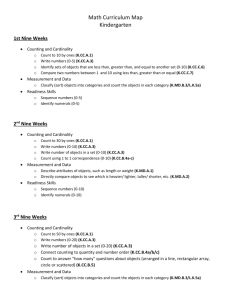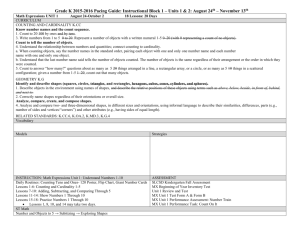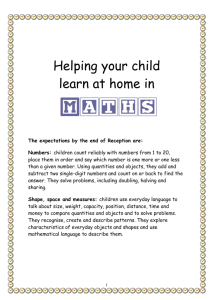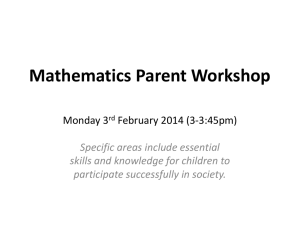Pre-K Standards - Michigan Math and Science Centers Network
advertisement
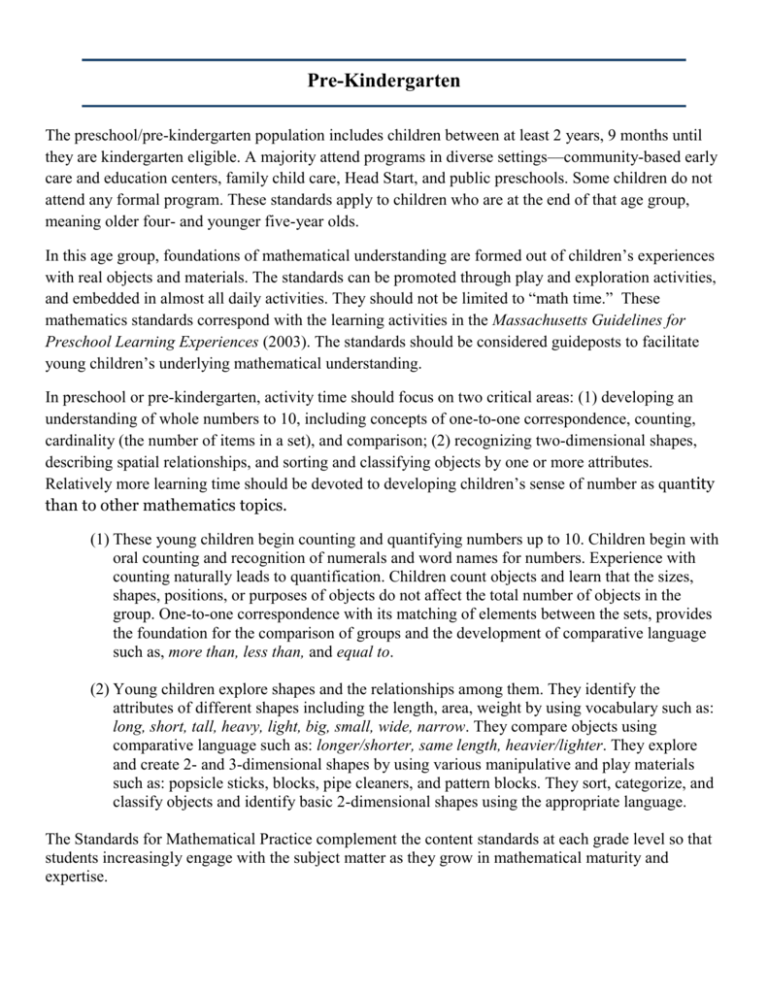
Pre-Kindergarten The preschool/pre-kindergarten population includes children between at least 2 years, 9 months until they are kindergarten eligible. A majority attend programs in diverse settings––community-based early care and education centers, family child care, Head Start, and public preschools. Some children do not attend any formal program. These standards apply to children who are at the end of that age group, meaning older four- and younger five-year olds. In this age group, foundations of mathematical understanding are formed out of children’s experiences with real objects and materials. The standards can be promoted through play and exploration activities, and embedded in almost all daily activities. They should not be limited to “math time.” These mathematics standards correspond with the learning activities in the Massachusetts Guidelines for Preschool Learning Experiences (2003). The standards should be considered guideposts to facilitate young children’s underlying mathematical understanding. In preschool or pre-kindergarten, activity time should focus on two critical areas: (1) developing an understanding of whole numbers to 10, including concepts of one-to-one correspondence, counting, cardinality (the number of items in a set), and comparison; (2) recognizing two-dimensional shapes, describing spatial relationships, and sorting and classifying objects by one or more attributes. Relatively more learning time should be devoted to developing children’s sense of number as quantity than to other mathematics topics. (1) These young children begin counting and quantifying numbers up to 10. Children begin with oral counting and recognition of numerals and word names for numbers. Experience with counting naturally leads to quantification. Children count objects and learn that the sizes, shapes, positions, or purposes of objects do not affect the total number of objects in the group. One-to-one correspondence with its matching of elements between the sets, provides the foundation for the comparison of groups and the development of comparative language such as, more than, less than, and equal to. (2) Young children explore shapes and the relationships among them. They identify the attributes of different shapes including the length, area, weight by using vocabulary such as: long, short, tall, heavy, light, big, small, wide, narrow. They compare objects using comparative language such as: longer/shorter, same length, heavier/lighter. They explore and create 2- and 3-dimensional shapes by using various manipulative and play materials such as: popsicle sticks, blocks, pipe cleaners, and pattern blocks. They sort, categorize, and classify objects and identify basic 2-dimensional shapes using the appropriate language. The Standards for Mathematical Practice complement the content standards at each grade level so that students increasingly engage with the subject matter as they grow in mathematical maturity and expertise. Pre-Kindergarten Overview Counting and Cardinality Know number names and the counting sequence. Count to tell the number of objects. Compare numbers. Operations and Algebraic Thinking Understand addition as putting together and adding to, and understand subtraction as taking apart and taking from. Measurement and Data Describe and compare measurable attributes. Classify objects and count the number of objects in each category. Work with money. Geometry Identify and describe shapes (squares, circles, triangles, rectangles). Analyze, compare, create, and compose shapes. Standards for Mathematical Practice 1. Make sense of problems and persevere in solving them. 2. Reason abstractly and quantitatively. 3. Construct viable arguments and critique the reasoning of others. 4. Model with mathematics. 5. Use appropriate tools strategically. 6. Attend to precision. 7. Look for and make use of structure. 8. Look for and express regularity in repeated reasoning. Counting and Cardinality PK.CC Know number names and the counting sequence. MI.1. Listen to and say the names of numbers in meaningful contexts. MI.2. Recognize and name written numerals 0–10. Count to tell the number of objects. MI.3. Understand the relationship between numerals and quantities up to ten. Compare numbers. MI.4. Count many kinds of concrete objects and actions up to ten, using one-to-one correspondence, and accurately count as many as seven things in a scattered configuration. MI.5. Use comparative language such as more/less than, equal to, to compare and describe collections of objects. Operations and Algebraic Thinking PK.OA Understand addition as putting together and adding to, and understand subtraction as taking apart and taking from. MI.1. Use concrete objects to model real-world addition (putting together) and subtraction (taking away) problems up through five. Measurement and Data PK.MD Describe and compare measurable attributes. MI.1. Recognize the attributes of length, area, weight, and capacity of everyday objects using appropriate vocabulary (e.g., long, short, tall, heavy, light, big, small, wide, narrow). MI.2. Compare the attributes of length and weight for two objects, including longer/shorter, same length; heavier/lighter, same weight; holds more/less, holds the same amount. Classify objects and count the number of objects in each category. MI.3. Sort, categorize, and classify objects by more than one attribute. Work with money. MI.4. Recognize that certain objects are coins and that dollars and coins represent money. Geometry PK.G Identify and describe shapes (squares, circles, triangles, rectangles). MI.1. Identify relative position of objects in space, and use appropriate language (e.g., beside, inside, next to, close to, above, below, apart). MI.2. Identify various two-dimensional shapes using appropriate language. Analyze, compare, create, and compose shapes. MI.3. Create and represent three-dimensional shapes (ball/sphere, square box/cube, tube/cylinder) using various manipulative materials, such as popsicle sticks, blocks, pipe cleaners, patternblocks, and so on.
